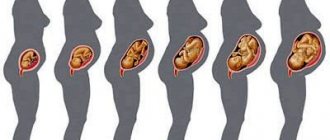How to check that the unborn child is developing correctly? This question is important for every expectant mother and doctor who is responsible for the health of both the pregnant woman and the baby. At the same time, we need a safe diagnostic method with accurate and reliable results. This applies to fetal cardiotocography (FCT). Based on the data obtained during the examination, the doctor decides whether emergency assistance during childbirth is needed.
The diagnostic and treatment center offers pregnancy management programs from 8, 12 and 22 weeks, as well as all necessary examinations during pregnancy, including fetal cardiotocography.
CTG during pregnancy - the essence of the method
The examination is carried out using a special monitor with sensors that record the baby’s heart rate and uterine contractions. Cardiotocography is a functional diagnostic technique that is based on the Doppler effect. It allows you to evaluate the following parameters of the vital activity and work of the fetal heart:
- Baby's mobility.
- Heart rate and changes in them during contractions of the uterus or fetal movements.
Indicators of uterine contraction and the baby’s cardiac activity are displayed on a thermal tape. By performing a CTG and combining both printouts, the doctor receives a picture from which one can determine the state of the fetal cardiac activity and notice possible problems in it. We will tell you the main thing about the technique: how long does CTG last, at what period is CTG done, how are the results deciphered.
How is cardiotocography performed?
Two sensors are placed on the front wall of the woman’s abdomen, one of which, using ultrasound, records and transmits the contractions of the child’s heart muscle and his motor activity to a special device for listening to the heartbeat. Changes in fetal heart rate are displayed as a graph on a paper strip. When performing this type of analysis, along with recording the baby’s cardiac activity, a second sensor records the contractile activity of the uterus.
The doctor performs CTG after the 28th week of pregnancy, when the child has already established a relationship between the nervous system and the heart muscle, and has also developed a rhythm of sleep and wakefulness.
CTG does not require special preparation for the study. It is enough to carry it out on an empty stomach or a few hours after eating. The CTG procedure lasts on average from 30 minutes to 1 hour and should coincide with the phase of fetal motor activity.
How is CTG performed?
During pregnancy, CTG is performed externally. In this case, the sensors are located on the abdomen (above the fetal heart and in the corner of the uterus, from where contractions begin to spread during contractions), and the woman has a special button in her hands, which she presses at those moments when she feels the baby moving.
CTG of the baby can be performed during pregnancy and during childbirth. During labor, cardiotocography is used to assess the condition of the child, the strength and dynamics of contractions. Based on this information, the doctor notices a violation of the blood supply to the fetus (hypoxia) and may decide to induce labor or an emergency caesarean section. In this case, both external and internal observation methods can be used. With it, one of the sensors (in the form of a spiral electrode) is inserted into the vagina and applied to the baby’s head. A second electrode is inserted into the amniotic sac and records uterine contractions. The internal method is used less frequently, and even during childbirth, observation is often done externally.
How often can cardiotocography be done?
Cardiotocography is a safe examination and does not affect the child’s development. In addition, CTG is completely painless; during it, you do not need to take any medications or do any additional medical procedures (injections, etc.). Therefore, there are no contraindications for performing CTG. This procedure can even be done daily and can be repeated for a long time if necessary.
CTG should be performed while the baby is awake. If he is sleeping during the examination, then you should not specifically wake him up. It’s just that the CTG time will lengthen a little or the study will have to be repeated.
CTG is included in the list of mandatory studies during pregnancy, and it can be done free of charge at any antenatal clinic or in nearby maternity hospitals. And of course, CTG can be done at any paid medical center that has a pregnancy monitoring program.
When is the best time to do fetal CTG?
CTG in the clinic, in most cases, is used from the 32nd week of pregnancy, since from this time the cyclicity of the child’s sleep and wakefulness patterns is established, which is why the result will be of better quality. Monitoring at earlier stages (starting from the 26th week) is also possible and will be quite informative, but is done only if necessary. An important point for the accuracy of the result is to correctly select the moment when the child is awake and most active. Typically, these are time periods:
- 9-14 hours.
- 19-24 hours.
There are also a number of rules that are important to follow during CTG:
- The procedure is not done on an empty stomach. Feeling hungry can change how your body reacts.
- Testing is not carried out immediately after eating (especially large and heavy meals). After a hearty meal, the body's main forces go to the digestion process.
- Ideally, choose a time 1.5-2 hours after eating.
- Before the procedure, you should not administer glucose, sedatives, magnesium, smoke, or drink alcoholic beverages.
- If the pregnant woman was actively moving (climbed the stairs, quickly went to see a doctor), then it is necessary to wait until the heart rate normalizes.
Special attention from medical personnel is required for overweight women, because fat deposits can muffle the baby’s heart sounds. The result may be distorted if the sensor is incorrectly applied (for example, it will record contractions of the mother's aorta).
At what stage of pregnancy is CTG performed?
CTG can be performed starting from the 28th week of pregnancy, but the most accurate indicators are obtained after the 32nd week .
This happens because the child’s nerve and muscle impulses mature precisely at this time. Also, by this time, the child has established a cycle of periods of activity and rest, which also affects CTG indicators. CTG can also be done during childbirth ; the technique for performing it will be the same as during pregnancy. If labor is progressing well, then there is no point in constantly being connected to a CTG machine; the study can be done periodically.
But if labor is stimulated, then CTG will have to be done more often, and this is justified, because the CTG schedule will show how effective the means that speed up the labor process are, and how the child reacts to uterine contractions. And having accurate data on the fetal heartbeat and contractile activity of the uterus, the doctor can more accurately calculate the dosage of medications and determine the delivery tactics most correctly.
Preparation
CTG takes place on an outpatient basis at a medical center where pregnancy monitoring is carried out. There is no need for the expectant mother to worry - the procedure is painless and does not threaten the pregnancy or the health of the child.
Cardiotocography is a routine and routine examination, the purpose of which is to ensure that the fetus does not experience oxygen starvation.
General recommendations from doctors when preparing for CTG:
- Get enough sleep and come to the medical center calm and rested.
- Eat in advance and calculate the time so that, taking into account the travel time, you do not get hungry, but also do not experience the feeling of overeating.
- Arrive a little earlier than scheduled to rest after the journey and calm down.
- Visit the toilet to feel comfortable during the examination, which lasts about half an hour.
- Do not smoke (even if for some reason you were unable to completely give up this habit).
How to prepare for research
CTG does not require special preparation. However, given the fact that the study lasts 40-60 minutes, you need to tune in to it, take a book or magazine with you (to somehow pass the time). Before the study, you should not overeat or, on the contrary, starve, because this can affect the baby’s behavior. The ideal option is to arrive rested, in a good mood and with a little snack. And of course, before going for a CTG, you must definitely visit the toilet - otherwise the examination time will seem like an eternity.
During this procedure, you need to take a comfortable position: reclining or lying on your side. There is no need to lie on your back - this is both uncomfortable and may affect the results of the study.
What will CTG show?
The doctor can draw conclusions about the condition of the fetus using the following parameters, which are determined by the procedure:
- Fetal heart rate per minute. Normally it should be between 120 and 160 beats per minute.
- Variability of the basal rhythm - the height of the heartbeat. Normally, the value is between 5-25 beats per minute.
- Acceleration is a short-term (15 s or more) acceleration of the number of heart contractions. The norm is two or more such accelerations in 10 minutes, as a reaction to fetal activity.
- Deceleration is a short-term decrease in heart rate (by 15 beats per minute). A normal indicator is the complete absence of such periods or their short duration.
CTG: interpretation of results
Having received the CTG results in the form of a special graph, the doctor deciphers them. Each criterion is scored from 0 to 2 points, then all the points are calculated to form an overall score. The doctor informs the expectant mother of the result.
- 9–12 points mean that the child is doing well and no abnormalities have been found. Pregnancy will be monitored as usual.
- 6–8 points indicate that the child is developing moderate hypoxia (oxygen starvation). To clarify the result, the doctor prescribes a repeat test - the next day or every other day.
- A score of 5 or less indicates that the child has significant oxygen deprivation. Sometimes urgent treatment is prescribed, in some cases even an emergency caesarean section is performed.
Also, during CTG, the child’s heart rate is determined. Normally, there should be from 110 to 160 beats per minute.
Sometimes the CTG conclusion contains the phrase: “The criteria are not met.” This means that for some reason the device’s sensor was unable to detect the child’s heartbeat. Perhaps the mother was lying incorrectly during the study or the sensor did not fit well to the woman’s abdomen. In this case, the CTG simply needs to be repeated.
Advertising
How is CTG performed?
This is one of the simplest and safest procedures, requiring only perseverance and good health from the patient. Fetal CTG takes from 30 to 60 minutes, the diagnostic room of our clinic is equipped with everything necessary for comfortable placement of the patient. It is recommended for a woman:
- come to the examination well-fed and take something with you to satisfy your hunger (for example, an apple, chocolate, banana), empty your bladder;
- try to choose for CTG the time of day when the fetus is most active - to obtain accurate results.
Decoding CTG
When deciphering CTG, the doctor takes into account several parameters:
- Basal rhythm (average heart rate over 10 minutes or more). The norm at rest is 110-160 beats per minute, the norm during fetal movement is 130-190 beats per minute.
- Rhythm variability (deviations from the average heart rate). The norm is 5-25 beats per minute.
- Deceleration (slowing down the heart rate during movements or contractions for 15 seconds or more). The norm is the absence of deceleration.
- Acceleration (increase in heart rate by 15 or more beats per minute for more than 15 seconds). The norm is 2 hits in 10 minutes.
When your baby moves, his heart beats faster for a few seconds. On the graph, this increase will be presented in the form of a tooth growing upward ( acceleration ). If at least two of them are marked on the chart over a ten-minute period, this is a good sign. Deceleration on the graph looks like teeth growing downward ( deceleration ). Do not worry if, after a short slowdown, the graph curve returns to the average level of the basal rhythm. High-amplitude decelerations are a reason to be wary. But the final conclusion should be drawn from the second graph, which shows contractions of the uterus - they can affect the occurrence of decelerations.
Cardiotocography is assessed on a ten-point scale (each parameter from 0 to 2 points). At the end of the procedure, the points are summed up.
A score of 8 points or higher is considered normal. 6-7 points indicate the possible presence of abnormalities in the condition of the fetus and the appointment of additional examinations. A score of 5 or less indicates that the woman is at risk and requires immediate hospitalization and early delivery by cesarean section.
However, when interpreting CTG, you must remember that the results obtained reflect the condition of the fetus at the time of the study. The baby’s heartbeat can depend on many factors, including weather conditions, the mother’s mood, etc. Changes in heart rate only indirectly indicate the presence of certain pathologies in the child. To obtain a more complete picture, additional studies (ultrasound, Doppler ultrasound) should be carried out, also taking into account the clinical picture and the nature of the disease.
The interpretation of the cardiotocogram depends on the period.
CTG of the fetus at 34 weeks is carried out according to the same indicators, but the variability may be higher than normal.
Fetal CTG at 36 weeks normally shows heart rate in the range of 120-160 beats per minute, variability - 10-25 beats, total number of points - less than 8.
Fetal CTG at 38 weeks should be within normal limits.
Once again, it is worth noting that cardiotocography indicators should be considered only in conjunction with data from other studies. CTG is an additional method in diagnosing fetal pathologies and shows only part of the processes occurring in the child’s body.
In a multidisciplinary medical center (St. Petersburg) you can do a CTG and thus assess the intrauterine condition of your baby, the child’s heart rate and diagnose possible threats to pregnancy and the fetus.
Specialists at our center advise expectant mothers to check the fetal heartbeat twice during pregnancy. If the pregnancy is difficult, CTG should be performed more often.
Why do fetal CTG?
The results of the study allow the gynecologist to determine methods for further management of pregnancy and provide important information that can help in the process of delivery. The use of CTG in combination with other diagnostic methods, such as ultrasound and Doppler, allows for a comprehensive assessment of the child’s condition. An ultrasound or Doppler test alone is not enough to find out whether the child has enough oxygen.
Cardiotocography allows you to track how uterine contractions and other physical activities affect the baby, and how the birth process itself will affect the baby. During delivery, CTG also makes it possible to monitor the condition of the fetus and, if necessary, change the tactics of labor management.
Why and when is fetal cardiotocography performed?
Cardiotocography is necessary for:
- determining the frequency of uterine contractions and fetal heart rate;
- general assessment of the child’s condition – both during pregnancy and during childbirth;
- identifying possible developmental pathologies.
In addition, indications for CTG are:
- risk of premature birth;
- pathologies of the placenta;
- umbilical cord entanglement;
- bloody discharge from the uterus;
- Rh conflict between mother and child;
- multiple births;
- chronic diseases of the patient;
- developmental delay, fetal inactivity;
- first pregnancy in adulthood.









